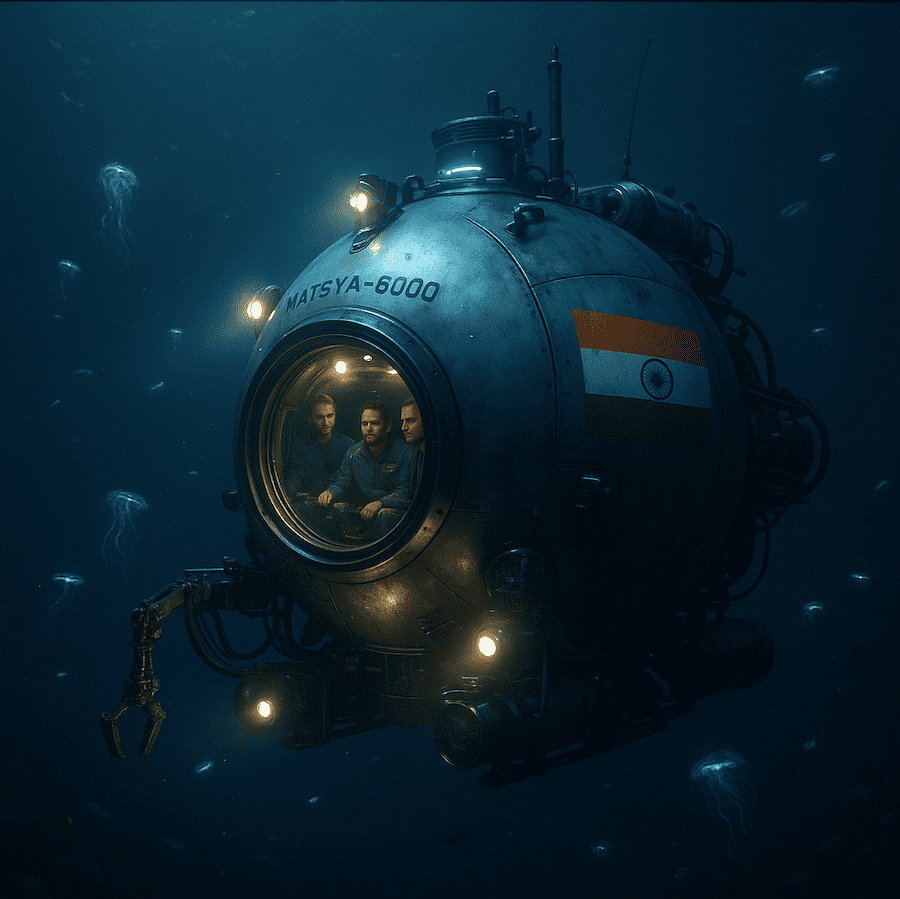Matsya-6000: India’s First Manned Deep-Sea Submersible
Matsya-6000: India’s First Manned Deep-Sea Submersible – Key Facts for CDS, NDA & CAPF 2025
India is pushing the boundaries of deep-ocean exploration with the launch of Matsya-6000, the nation’s first manned deep-sea submersible. Developed under the Samudrayaan Mission and the broader Deep Ocean Mission, Matsya-6000 will enable direct human access to ocean depths of up to 6,000 meters.
What is Matsya-6000?
Matsya-6000 is a crewed submersible designed by the National Institute of Ocean Technology (NIOT), Chennai. It can carry three aquanauts to extreme depths of 6,000 meters, placing India among the few nations—like the US, Russia, Japan, France, and China—with such capability.
This mission is often compared with ISRO’s Gaganyaan mission in space, as both signify India’s dual exploration frontiers: space and ocean.
Latest News and Trials
Matsya-6000 has undergone dry and wet trials at the L&T Shipbuilding facility near Chennai.
It has successfully completed eight dives (both unmanned and manned).
Next step: shallow-water trials up to 500 meters in 2025.
Final goal: full-depth mission of 6,000 meters by 2026.
These trials tested its life-support systems, navigational control, and structural strength to ensure aquanaut safety during long-duration deep-sea missions.

Key Features and Technology of Matsya-6000
1. Structural Design
Sphere: 2.1-meter diameter, 80mm titanium alloy sphere developed with ISRO support.
Hull: Built to withstand crushing pressures and freezing temperatures at extreme depths.
2. Life-Support and Safety
Endurance: 12 hours of continuous operations.
Emergency Support: 96-hour backup system.
Redundancy: Triple-layered power, buoyancy, and life-support systems.
Emergency Resurfacing: Automatic flotation using syntactic foam.
3. Navigation and Communication
Propulsion: Advanced propellers with maneuvering capability.
Navigation: USBL acoustic positioning system.
Communication: Acoustic modem, telephone, and VHF radio.
Robotic Arms: For sample collection.
4. Scientific Payloads
Sensors & Imaging: High-resolution cameras and scientific instruments.
Research Tools: Robotic manipulators for seabed exploration.
Exploration Focus: Polymetallic nodules, hydrothermal vents, biodiversity, methane seeps.
Objectives of Matsya-6000 Mission
Mineral Exploration – Survey cobalt, manganese, copper, and rare metals critical for electronics and clean energy.
Biodiversity Studies – Document deep-sea life forms and ecosystems.
Technology Advancement – Boost India’s capability in extreme marine engineering.
Aquanaut Training & Ocean Literacy – Develop human resources for sustained ocean exploration.
Significance of Matsya-6000 for India
Strategic Edge: Joins elite club of deep-ocean capable nations.
Scientific Gains: Enhances marine research and innovation.
Economic Impact: Supports Blue Economy goals by unlocking marine resources.
National Vision: Aligned with Atmanirbhar Bharat and Vision 2030.
Timeline and Roadmap
2021: Project approved under Deep Ocean Mission.
2023–2025: Major design and integration milestones achieved.
Early 2025: Dry and wet tests completed.
Late 2025: Shallow and mid-water trials (up to 500 meters).
2026: Planned full-depth (6,000 meters) manned mission.
Sample Questions for Competitive Exams
| Question Type | Sample Question | Answer |
|---|---|---|
| One-liner/Static GK | Who developed India’s first manned deep-sea submersible Matsya-6000? | NIOT, Chennai |
| Current Affairs (2025) | What is the maximum depth capability of Matsya-6000? | 6,000 meters |
| Application/Contextual | Explain the significance of Matsya-6000 in India’s Blue Economy policy. | Exam-oriented descriptive answer |
| Science & Technology | What material and thickness is used in Matsya-6000’s sphere? | Titanium alloy, 80 mm |
| Mission/Policy | Under which mission is Matsya-6000 being developed? | Samudrayaan / Deep Ocean Mission |
FAQs about Matsya-6000
Q1. What is Matsya-6000?
Matsya-6000 is India’s first manned deep-sea submersible, designed to dive up to 6,000 meters under the Samudrayaan Mission.
Q2. Who developed Matsya-6000?
It is developed by the National Institute of Ocean Technology (NIOT), Chennai.
Q3. What is the main objective of Matsya-6000?
To explore deep-sea minerals, biodiversity, and ecosystems while advancing India’s marine technology.
Q4. How many people can Matsya-6000 carry?
It can carry three aquanauts.
Q5. When will Matsya-6000 attempt its first full-depth mission?
The 6,000-meter manned dive is planned for 2026.
Q6. How is Matsya-6000 linked with India’s national goals?
It supports Atmanirbhar Bharat, Blue Economy, and Vision 2030, boosting resource security and strategic autonomy.
Conclusion
Matsya-6000 marks a milestone in India’s technological and scientific progress. By enabling direct human access to the deepest parts of the Indian Ocean, it strengthens India’s role in marine research, resource exploration, and strategic security.
For CDS, NDA, and CAPF aspirants, Matsya-6000 is an essential topic under current affairs, science & technology, and national missions—making it a high-value addition to exam preparation.





